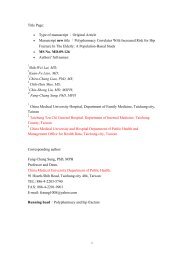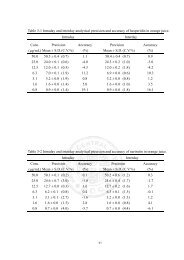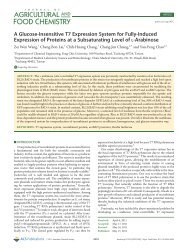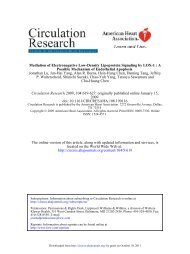Culinary Narratology in Everyday Life: Foodways and Identity ...
Culinary Narratology in Everyday Life: Foodways and Identity ...
Culinary Narratology in Everyday Life: Foodways and Identity ...
Create successful ePaper yourself
Turn your PDF publications into a flip-book with our unique Google optimized e-Paper software.
<strong>Cul<strong>in</strong>ary</strong> <strong>Narratology</strong> 22<br />
Ashima constantly discuss the issue with<strong>in</strong> this community: “Each step, each acquisition, no<br />
matter how small, <strong>in</strong>volves deliberation, consultation with Bengali friends” (64). After<br />
Gogol’s annaprasan, there come more gather<strong>in</strong>gs with elaborate feasts, <strong>in</strong>clud<strong>in</strong>g Sonya’s<br />
annaprasan, birthday parties <strong>and</strong> every Indian as well as American festival. Gradually, the<br />
Gangulys acquire new patterns <strong>in</strong> their immigrant life: “Every weekend, it seems, there is a<br />
new home to go to, a new couple or young family to meet. They all come from Calcutta, <strong>and</strong><br />
for this reason alone they are friends” (38). Communal gather<strong>in</strong>gs have become an<br />
important facet of Ashima’s diasporic life. Be<strong>in</strong>g a dutiful hostess <strong>and</strong> prepar<strong>in</strong>g all the<br />
foods, though exhaust<strong>in</strong>g, has become a way that she can def<strong>in</strong>e herself <strong>in</strong> the US.<br />
The role of Indian feasts is reconfigured as a cultural signifier <strong>in</strong> The Namesake, as they<br />
are shown as be<strong>in</strong>g crucial for the construction <strong>and</strong> ma<strong>in</strong>tenance of Indian communities <strong>in</strong> the<br />
US. On the <strong>in</strong>tertw<strong>in</strong>ed relationship between foodways <strong>and</strong> identity formation, food <strong>and</strong> its<br />
various representations function as markers of cultural difference which generate the<br />
formation of collective as well as <strong>in</strong>dividual identities with<strong>in</strong> diasporic contexts. This<br />
apparent mundaneness <strong>and</strong> anchorage <strong>in</strong> everyday life has always endowed Indian food with<br />
a significance that is re<strong>in</strong>forced <strong>in</strong> another country, <strong>and</strong> it is consumed as both material <strong>and</strong><br />
cultural sustenance. To borrow Rushdie’s notion, Kunow notes that, on a cultural level,<br />
Indian food is essentially a representation deployed to support the construction of Indian<br />
diasporic communities as an “Imag<strong>in</strong>ary Homel<strong>and</strong>” (157-58). In this regard, what is of<br />
particular significance here is how food <strong>and</strong> related behaviors have been <strong>in</strong>vested with the<br />
potential to mediate distances from the subcont<strong>in</strong>ent. Among all food related behaviors, the<br />
rout<strong>in</strong>e gather<strong>in</strong>gs of Indian immigrant families is of particular importance <strong>in</strong> The Namesake.<br />
The close relationship between food <strong>and</strong> communal identity can also be traced back to<br />
premodern or primitive societies, where “the rituals of eat<strong>in</strong>g, shar<strong>in</strong>g food <strong>and</strong> other<br />
activities around food serve to be an <strong>in</strong>tegrative mechanism for the whole community” (Falk<br />
24-25). This notion of shar<strong>in</strong>g food <strong>and</strong> form<strong>in</strong>g a collective identity is further enhanced









